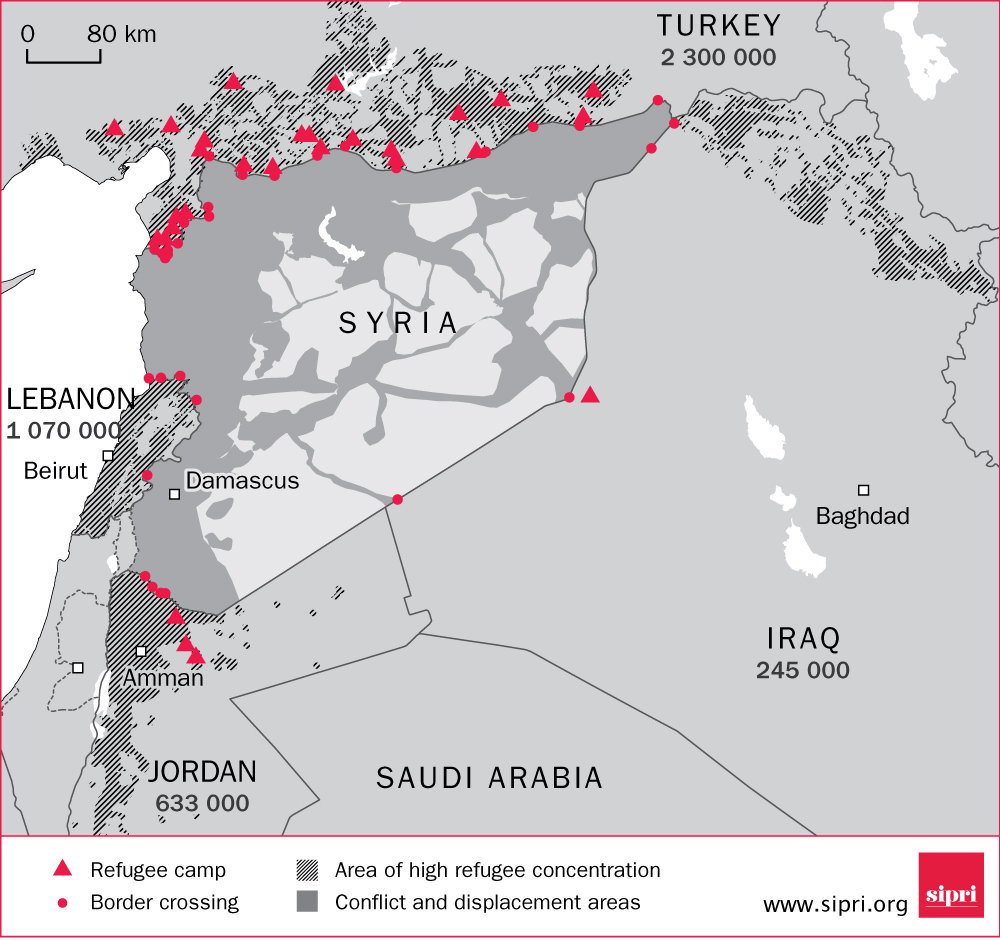2. Armed conflict in the Middle East
Overview, Ian Davis [PDF]
I. The Middle East: 2015 in perspective, Dan Smith [PDF]
II. The aims, objectives and modulus operandi of the Islamic State and the international response, Ian Davis [PDF]
III. How are refugee flows changing the Middle East? Maha Yahya [PDF]
IV: The Kurds in the Middle East, 2015, Soli Özel and Arzu Yilmaz [PDF]
V. Iran's dynamics with other states in the Middle East, Rouzbeh Parsi [PDF]
In 2015, the Middle East remained an area of major insecurity, and a source of profound problems and challenges for neighbouring regions, most notably in the form of the terrorist attacks in Paris and elsewhere and the displacement of huge numbers of refugees.
Among the key developments in the year were: the intensification of military attacks against Houthi insurgents and their allies in Yemen by a coalition of countries led by Saudi Arabia; continuing warfare in Syria and the entry of Russia into the war in September 2015; continuing and increasingly random violence between Israel and Palestine; a worsening civil war in Libya, with the Islamic State (IS) gaining ground in some eastern coastal areas; challenges to the Iraqi Government from both IS and the separatist claims of Kurdish leaders; and in Egypt an escalating conflict in the Sinai involving an IS affiliate, which claimed responsibility for the in-air destruction of a Russian airliner in 2015.
The Islamic State and the international response
In 2015, IS controlled large areas of Iraq and Syria, and had affiliates and supporters in several other states. The group directed tens of thousands of fighters in Iraq and Syria, and terrorist attacks attributed to IS outside those two countries demonstrated its ability to threaten societies in the wider Middle East, Africa, South Asia and Europe.
Provoking direct confrontation with hostile powers and targeting populations seem to be core aims of the group and a part of what its leaders see as a prophesized civilizational conflict. The interdependent nature of the conflicts and political crises in Iraq, Syria and other countries where IS fighters operate complicates efforts to address the threat, as does the wide range of countries from which it recruits fighters and other kinds of support. In order to defeat IS, it will be necessary to defuse the Sunni Muslim revolt that has been building across the Arab world since 1979, cool the competition for influence and supremacy between Sunni Saudi Arabia and Shiite Iran, and address the social and cultural background to radicalization.
Refugee flows changing the Middle East?
The wars in Iraq and Syria have displaced around 4 million Iraqis and 12 million Syrians. The three countries that currently host the most refugees are Jordan, Lebanon and Turkey. A substantive new underclass of citizens has emerged in four Arab countries: in Syria and Iraq, millions of internally displaced persons are living in precarious conditions, on the run in their own land; in Lebanon and Jordan, refugees have settled in the poorest regions of both countries, triggering a growth in vulnerable populations. If left unaddressed, the fallout from identity-based polarization in the region and the expansion in vulnerable populations will have further profound repercussions for regional and international stability.
Syrian refugees in neighbouring countries

The Kurds in the Middle East, 2015
There were important developments in the political trajectory of the Kurds in Turkey, Iraq and Syria during 2015. The estimated 30 million Kurds generally held their own both politically and militarily, and will continue to be an inseparable and difficult to ignore part of the region’s politics. In Turkey, a political path to the resolution of the Kurdish issue was blocked, but in Iraq and Syria Kurdish forces won unequivocal victories against IS, which increased their legitimacy in the West and enabled them to expand the areas under their control. However, the political end point for the Kurds in Turkey, and whether there is life after IS for the aspirations of Syria’s and Iraq’s Kurds to pursue their own political destiny, remain unclear.
Iran’s Middle East dynamics
The July 2015 agreement regulating Iran’s nuclear technology programme stood out as an example of cooperative management of conflict risk. However, complex technical and political questions remain over implementation and verification. Iran has evolved over the past 20 years into a status quo power trying to maintain relationships and its own role in the region. Iran’s current clout in regional affairs stems mainly from the lack of stability of its neighbours. Its relations with Saudi Arabia have deteriorated, however, and this is affecting conflict zones across the region.